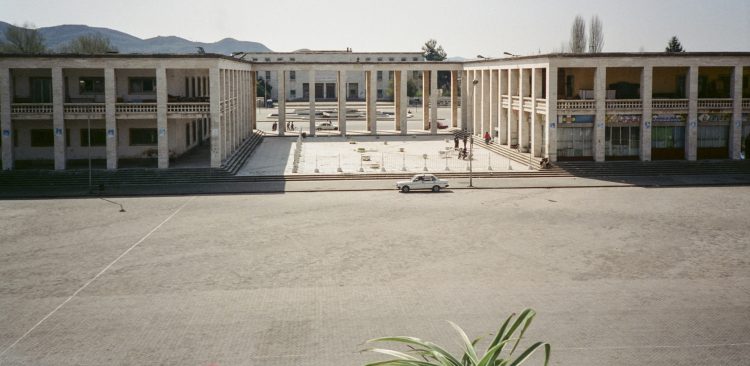“(Re)Connection with the public sphere” is the exhibition in the Zeta Gallery, open to the public from 11th -30th of May 2018, with participating artists: Iris Andraschek and Hubert Lobnig, Gelit, Werner Reiterer, Anna Meyer and Franz Kapfer. The aim of the exhibition is the review of public space from the point of view of contemporary artists from Austria.

The idea of this activity is credited to a artist called Hubert Lobnig, who visited Tirana for the first time in 1992. This idea arose from his comparative observations on the fundamental changes of the Albanian society’s relationship with the public space of the capital.
Photos of Iris Andraschek and Hubert Lobnig represent borders, including a certain state of mind on both sides of the frontier, or physical transendences , reflecting his opposition by reason of human will.The photos displayed in the exhibition reflect an installation titled “Where Do The Borders Go“, which carries the idea of border violation in their country of origin as a question to the national policies towards the state administrative demarcation.
A series of photographs, taken by Hubert Lobnig in Tirana in 1992, portray the former Albanian capital in ruined urban areas (buildings of architectural value or not, destroyed cars abandoned in public spaces); artists ateliers; portraits of once rebellious artists – today politicians (Edi Rama); the presentation of forms of the totalitarian past (bunkers); a view of the daily vitality of the 90’s in the capital which does not resemble at all with the later under the artist’s lense.
In this exhibition, artist Anna Meyer reflects on social events such as citizen protests at the Heldenplatz in Vienna. The protests appear from two perspectives: inwardly and outwardly of the protest. Naturally the two forces collide: society and the state.
The ideas of the artist are elaborated through the painting medium (oil on glass and canvas) and its performance (faceburka). All this is a reflection of the role of virtual social networks in relation to the public sphere, where the action takes place. Meyer’s works are a testimony to the artist’s active role in today’s social phenomena.
The group of artists called Gelitin uses at the service of art one of the distinguishing features of human physiognomy: the nose, which often serves as an ethnic or racial identification. From a sensory organ, personalizing body, thanks to Gelit’s artists, the nose turns into an artistic public object: a monument in a rural area in Austria (2014). According to the curatorial text, this is just an ironic game with the company of a giant, buried on the ground with his exhausted nose on the surface.
At the Zeta Gallery exhibition, the Gelitin artists come with a series of photos that represent the entire progress of the artist’s work (the monument of the nose), as well as a drawing depicting the interaction of people with the monument.
Werner Reiterer attends the exhibition with three drawings representing different angles of a bunker. The feature of Reiterer’s bunker is precisely the presence of the sky: inside and outside it, as a feature that points to infinity even within forced physical separation as a result of a certain ascendancy.
Identifying elements of a nation or another – in this exhibition included through symbols are the Balkan countries, including Albania – serve Franz Kapfer for the construction of an installation. Describing Gjergj Kastrioti Skanderbeg’s image perhaps as a myth (as a figure dressed in a false legendary attire or fairytale) he attempts to demythologize it by placing his helmet atop a spear.
According to the curatorial text, generally Franz Kapfer uses flags, emblems, monuments, figures of Catholic saints in his urban installations, aimint to play with people’s perspective for everyday things on which he offers his standpoint through his work.
* Born in 1964 in Grac; lives and works in Vienna; studied graphic art at the Academy of Fine Arts in Vienna.
* Born in 1964 in Shafhausa (Schaffhausen), Switzerland; lives and works in Vienna; graduated in Art and Design Schools in Zurich and Lucerne.
* Born in 1971 in Fürstenfeld; lives and works in Vienna; studied sculpture at the Academy of Fine Arts in Vienna.
* Born in 1963 in Horn; lives and works in Vienna, Austria; studied at the Vienna Academy of Fine Arts, at the “Fresco” school, in Bolzano and at “Scuola Arti Ornamentali” in Rome.
* Born in 1962 in Völkermarkt; lives and works in Vienna, Austria; studied at the University of Applied Arts in Vienna.
Artistic group of four members, who live and work in Vienna; they have joint international exhibitions since 1993.
